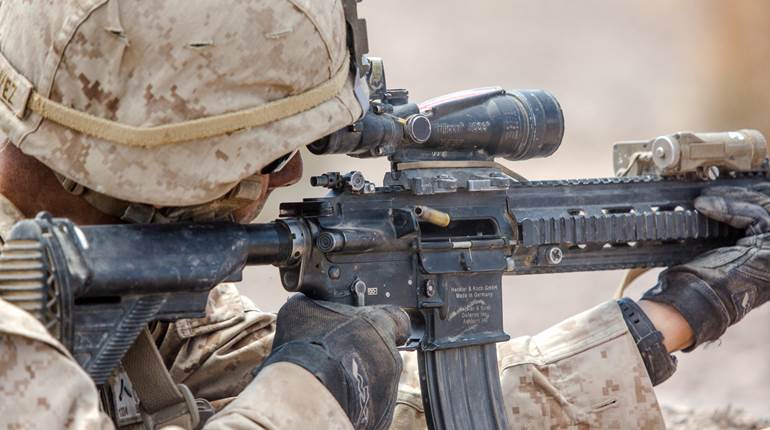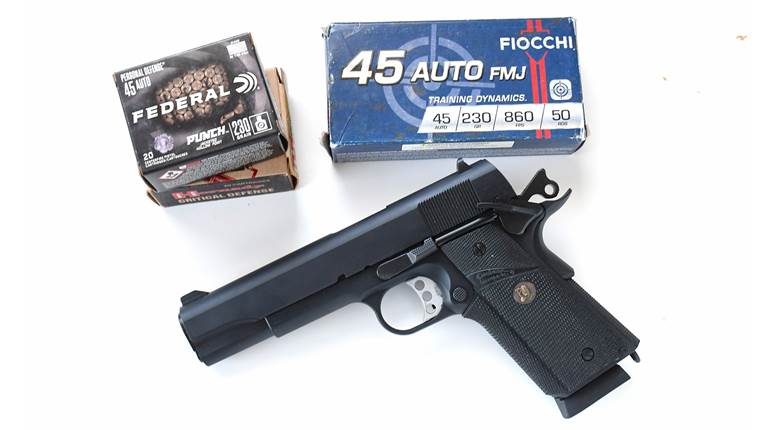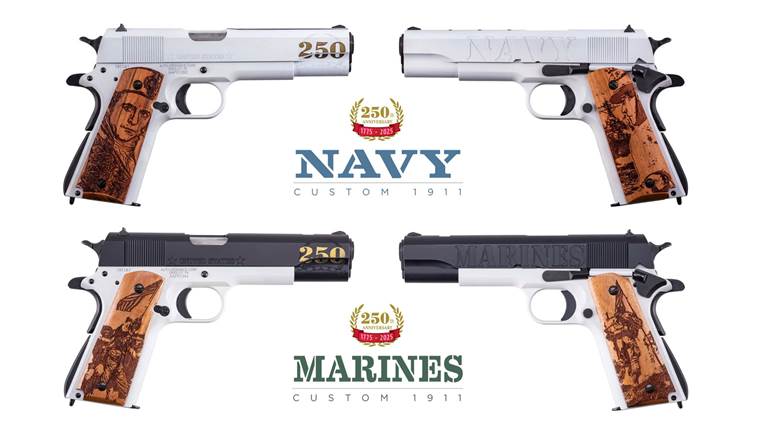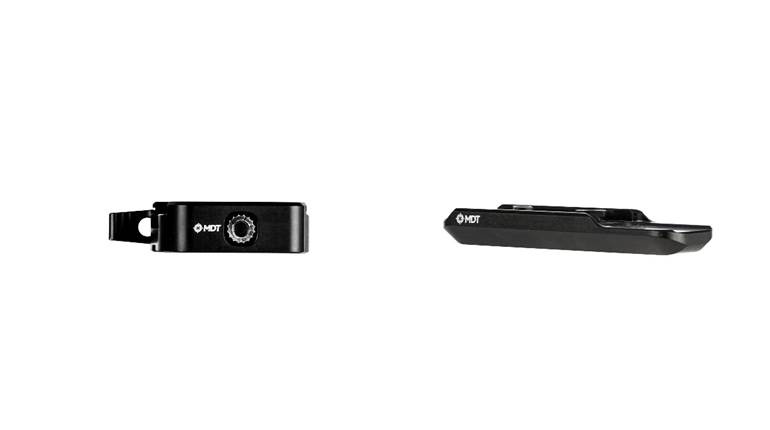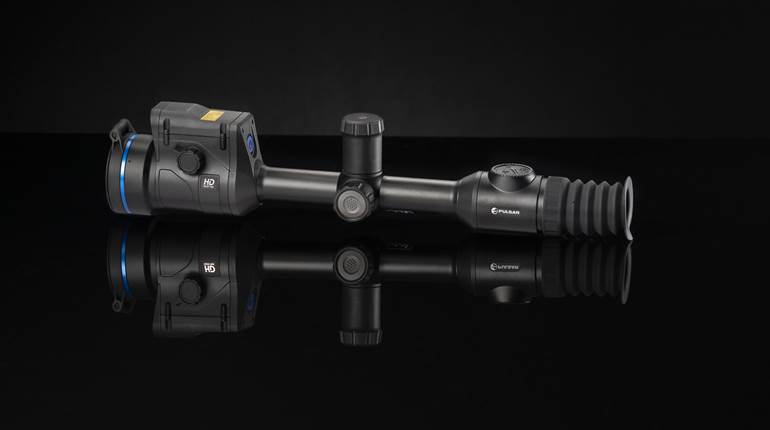
In “Banana War Ambush” by Marine Corps Historical Artist Col. Charles H. Waterhouse, USMCR, (Ret.), a lone Marine with his ‘03 Springfield fights for his life on a jungle trail. “Horse Marines” were in evidence throughout the Caribbean and Central America during the “Banana Wars.
A squad of Marines crept quietly forward through the hot, steamy and tangled Haitian jungle, index fingers hovering near the triggers on their weapons. Captain Jesse Perkins, himself a seasoned veteran of jungle engagements since the 1899 Samoan campaign more than 20 years before, silently signaled to his men and pointed out the hideout of the Haitian Caco bandit chieftain, Benoit de Batraville. The Marines were anxious to find de Batraville, since, after the death of Charlemagne Peralta—at the hands of Garde d’Haiti Lt. Herman Hanneken and his .45 M1911 Colt pistol a few months before—he became the chief Caco in what has now become known as the Second Haitian Campaign. In order to bolster his mystique and aura of invincibility among his rag-tag followers, de Batraville had cannibalized a mortally wounded Marine serving as an officer in the Garde d’Haiti, Lt. Lawrence Muth. After ambushing Muth’s patrol a few weeks previously, the bandit chief had cut out and eaten Muth’s heart, while smearing Muth’s brains on the stocks of his men’s rifles, ostensibly to improve their marksmanship.
Gunnery Sergeant Albert A. Taubert moved into position among the jumbled rocks at the entrance of a cavern, with his M1911 .45 Colt pistol in hand. Taubert, a holder of the Navy Cross, the Distinguished Service Cross, the Italian Medal of Valor and the French Medaille Militaire for his actions during the battle of Soissons in World War I, had volunteered for duty in Haiti so that a married comrade could remain at the Portsmouth Navy Yard. Suddenly, de Batraville appeared in the mouth of the cave, firing his .38 Colt revolver at the squad of Marines. Taubert stepped forward and returned fire, blowing a hole through the Caco chief’s gun belt and killing the bandit leader. For this feat, he was awarded a second Navy Cross, and it signaled the end of the 1919-1920 Second “Caco” War. Taubert kept the bandit chief’s gun and holster rig as a trophy of war.
The Marine Corps had adopted the U.S. Model of 1911 pistol in 1912, and the officers who went ashore at Vera Cruz, Mexico, during the 1914 intervention carried them in both versions of the M1912 holster —mounted and dismounted—with “USMC” stamped on their flaps. In the first Haitian campaign of 1915, several Marines were awarded the Medal of Honor while armed with .45 pistols. The most famous of those was Smedley Butler, who received his second Medal of Honor for bursting through the decrepit brick-walled drainage ditch of a derelict French fort that was serving as the hideout for a band of Cacos and, with only two Marines beside him, engaging scores of bandits with his pistol. The M1911 pistol served in every action during the Banana Wars from Vera Cruz to the final withdrawal from Haiti and Nicaragua in the early 1930s. During the Second Nicaraguan campaign, some Marines carried their pistols in long, specially converted M1916 holsters, also marked “USMC.”
The term “Banana Wars” referred to a series of interventions, nearly all by the U.S. Navy and Marine Corps, in the Caribbean and Central America in the years between the Spanish-American War and the mid-1930s. While there were several valid reasons for these various interventions, the major justification was the “protection of American property and citizens” from the vagaries of popular uprisings and civil war in those countries. Since the “American property and citizens” were, for the most part, involved in the tropical fruit industry—mainly banana plantations—the informal name served as an understandable catchall term.
As noted in the first installment of this series, although the service pistol and rifle—the M1911 Colt pistol and the M1903 Springfield rifle—served throughout most of the early Banana Wars and through all of the later campaigns, the automatic arms used in the Banana Wars changed dramatically after the Marine Corps’ experience in World War I. Whereas the pre-World War I campaigns in Cuba, Nicaragua, Mexico, Haiti and the Dominican Republic were fought by Marines armed with Benet-Mercie machine rifles and Colt “potato digger” machine guns, starting with the second Haitian “Caco” War in 1919, Marines were supported in the later Banana Wars by the rapid fire of the Lewis light machine gun, the Browning Automatic Rifle, the Thompson submachine gun, and to a lesser extent, the Browning M1917 water-cooled machine gun. All of those arms then served into at least the early days of World War II, and some even into the early 1960s.
Finally dismayed at the fragile and unreliable Benet-Mercie machine rifle, the U.S. Army opted to replace it, and its obsolete M1904 Colt-Maxim heavy machine gun, with the British-designed Vickers machine gun in 1915. However, the Vickers was a heavy, tripod-mounted, and water-cooled gun. In 1917, the U.S. Navy decided to adopt the Lewis light machine gun, which was then being manufactured by the Savage Arms Co. in Utica, N.Y., for the British. An American invention, but produced and used overseas because of a long-standing dispute between the inventor, Col. Isaac N. Lewis, and the U.S. Army’s Chief of Ordnance, the American version of the bipod-mounted, shoulder-fired machine gun was chambered in .30 U.S. (.30-’06 Sprg.)
Firing 47 rounds out of its distinctive top-mounted drum magazine, the air-cooled Lewis gun quickly became a favorite of Marines. Although the Marines’ Lewis guns were taken away from them and replaced with the questionable French Chauchat automatic rifle shortly after landing in France, those Marines patrolling the Caribbean islands during World War I kept a lid on local unrest with their Lewis guns. When the second Caco revolt broke out in Haiti in 1919, Lewis guns were used in many of the actions. In addition, many of the Marines’ aircraft were also equipped with Lewis guns mounted on Scarff rings in the “rear seat.” Both Marines and the Guardia National de Nicaragua used Lewis guns in Nicaragua during the late 1920s and the early 1930s. The Guardia was yet another native constabulary very much similar to the Garde d’Haiti and the Dominican National Guard that the Marines had instituted in those countries. As in Haiti and the Dominican Republic, these native constabularies were, for the most part, armed with obsolescent Krag rifles, and officered by Marines on detached duty. The first of the famed Coco River Patrols, led by the noted Marine, “Red Mike” Edson, carried Lewis guns on its grueling expedition by boat up Nicaragua’s unpredictable and dangerous Coco River, but Edson later opted for Thompson submachine guns on the final push against the Sandinista rebels.
In his book, Chesty, one of the Corps’ best historians, Col. Jon T. Hoffman, recounts an ambush in Nicaragua involving the legendary duo of Lewis B. “Chesty” Puller and “Ironman” William A. Lee, in which Lee was wounded, but when he recovered during the battle, Lee: “[S]truggled to a pack mule and retrieved the unit’s Lewis gun. The guardia lieutenant then demonstrated equal parts determination and marksmanship as he employed the weapon with telling effect against the rebels. His accurate bursts cooled the ardor of the bandits and incoming fire began to die off. Puller seized the advantage Lee had won. The company commander jumped to his feet, called for a charge, and dashed uphill toward the right half of the enemy line. His guardias followed. The Sandinistas in front of them fled.”
Although the Lewis gun was largely replaced by the M1919 Browning light machine gun in the late 1930s, Marines of the Fourth Regiment—recently arrived from long-time service in Shanghai—were still manning their Lewis guns as late as 1942, during the defense of the Philippine island of Corregidor.
Marines enthusiastically embraced the M1918 Browning Automatic Rifle, commonly known as the “BAR,” when it was introduced into the American Expeditionary Forces in the autumn of 1918. Although its only combat use in France by Marines was literally on the last night of the war, the Marine Corps put the selective-fire rifle to good use during the Banana Wars, and had even more success with its successor, the variable-fire M1918A2, in World War II and the Korean War, until it was finally phased out shortly before the Vietnam War. Firing the standard service rifle cartridge from a 20-round detachable magazine, the BAR gave the extra firepower needed in the brief and violent ambushes that had become the hallmark of the Banana Wars.
Perhaps the most notable use of the BAR during that period was in the hands of Marine Cpl. William R. Button, who was serving with a detachment of Haitian Garde d’Haiti as a lieutenant. In a story that would be considered as unbelievable were it to be seen today in movie theaters, Button, his commanding officer, Marine Sgt. Herman Hanneken (Captain, Garde d’Haiti) and 10 native gendarmes, bluffed their way into the camp of the bandit chief, Charlemagne Peralta, during a battle that the two Marines had orchestrated in order to draw Peralta out of hiding. When Peralta chose to avoid the battlefield and stay behind in camp while the fighting raged a few miles away, this small group successfully passed through several Caco outposts, disguised in part by the Marines’ faces and hands being covered in burnt cork. Button even evaded a comment about his BAR from one of the Cacos, and responded to the question in the local patois, a mixture of French and African Creole. Upon reaching the Caco camp, Hanneken quickly dispatched Peralta with his pistol, while Button, assisted by the loyal gendarmes, kept the Cacos at bay throughout the night with accurate and heavy BAR and rifle fire, thus preventing the bandits from reclaiming their chief’s body.
In spite of the BARs effectiveness, the most immediate solution to the ambush problem in what became known as the “Second Nicaraguan Campaign” was the Thompson submachine gun. Developed during World War I as a “trench broom” by a retired Army Ordnance officer, Brig. Gen. John Taliaferro Thompson, the “Tommy Gun” fired the standard .45 ACP pistol cartridge from either a 50-round drum or a 20-round “stick” magazine. Marines were well acquainted with the new gun by that time as they were using it to guard the U.S. Mail in 1926, shortly before shipping out to Nicaragua and China with Thompsons in 1927. Marine Gen. Richard M. Cutts had designed its familiar muzzle brake—the “Cutts Compensator.” Moreover, Marines had been testing and evaluating the submachine gun and its early 100-round magazine at Quantico in the early 1920s. The Thompson gun proved to be an invaluable asset in the Nicaraguan jungle, and was usually carried by a non-commissioned officer at the “point” of a Marine patrol or a combined force of Marines and native constabulary.
Although the Thompson submachine gun was often employed by Marine patrols throughout northern Nicaragua, perhaps its most constant use in that country was with Company M of the Nicaraguan Guardia. The officer commanding Company M was none other than “Chesty” Puller, arguably one of the most well-known Marines of all time, who was ably assisted by his second in command, “Ironman” Lee. Company M (for “Mobile”) had been formed to take the fight directly to the rebels by means of continual and aggressive patrolling, and, with most of the command being native Indians from northern Nicaragua, they succeeded. While the standard shoulder arm for all of the native constabularies was the .30 Army Krag rifle, several of Company M’s men were issued Thompson submachine guns, as well as BARs, M1903 Springfield rifles equipped with rifle grenades and, as recounted earlier, Lewis guns. Although Puller apparently preferred the BAR to the Thompson, both were used to great effect in the scores of fighting contacts that Company M had with the Sandinistas.
Accounts of Marine patrols also often refer to Thompson guns and their effectiveness. Conversely, whenever the Sandinistas captured American or Guardia weapons, especially automatics, they also put them to good use. Author Ivan Musicant tells one such story in his book, The Banana Wars, about a Marine patrol commanded by Capt. Robert Hunter that ran into a Sandinista ambush: “Within minutes a heavy volume of rifle and automatic fire from at least 100 guerillas in the ravine and atop a hill to the left front opened on the point … . A corporal fell dead. The navy hospital corpsman picked up the dead man’s Thompson submachine gun, but being unfamiliar with the piece, could not fire. Hunter grabbed the gun. On his way back to the crest, Hunter stopped and in a standing position, fired into the bandits and felled two of them, but in turn was shot in the chest by a bandit Thompson at a range of 50 yards.”
Patrolling through the Nicaraguan jungles by foot or by horseback was not the kind of war in which heavy water-cooled machine guns could readily be deployed. However, there were instances in which M1917 Browning machine guns played a significant role. During the epic defense of the Nicaraguan town of Ocotal, the commanding officer, Capt. Gilbert Hatfield, directed the gunners firing the detachment’s lone heavy Browning at the attacking rebels. Although known primarily for the orchestrated dive-bombing attack that lifted the siege, Ocotal was a fierce battle on the ground, and the work of the lone Browning gun was recognized as being one of the contributing factors to the success of the Marines and Guardia. Later, when several Marine columns were closing in on the bandits’ main defensive position, El Chipote, there were several clashes in which the Marines brought Vivien-Bessieres rifle grenades, Stokes mortars, and even a 37 mm anti-tank gun into action in addition to heavy Browning machine guns.
With all of that firepower and weaponry, however, it was the courage and dedication of the Marines and their native allies that determined the final outcome in the hundreds of small actions throughout the Banana Wars. The lessons learned from fighting in an arena of tropical disease, while suffering horrendous heat and humidity, subsisting on scant rations, and being in near-constant action paid great dividends for the Marines of World War II during their drive across the Pacific.
The author thanks the staff of the Marine Corps History Division, the National Museum of the Marine Corps, and the Marine Corps Archives for their wholehearted and enthusiastic assistance in the preparation of this article.
Addiitional Reading:
Guns of the Banana Wars, Part One













